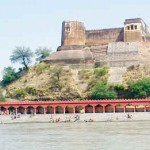Nagendra Singh Jamwal
Just as Akhnoor finds a place of pride in history for its antiquity and  historical importance, the Jia Pota Ghat on the right bank of Chandrabhaga i.e. today’s Chenab at Akhnoor is the crowning glory of this ancient town.
historical importance, the Jia Pota Ghat on the right bank of Chandrabhaga i.e. today’s Chenab at Akhnoor is the crowning glory of this ancient town.
Any old timer of Akhnoor will reveal that Jia Pota Ghat is one of many ghats situated on the right bank of Chenab, the other being Pehra, Gurgi Pattan and Harmandar (named after Hari Mandir) situated downstream.
Interestingly the Jia Pota Ghat got its name from the Jia Pota tree whose botanical name is Putranjiva roxburghii of Euphorbiaceae family under whose shade the Raj Tilak ceremony of Maharaja Gulab Singh took place. The coronation at the ghat would always remain etched in the collective psyche of the people of this state and more particularly the Dogras as the first concrete step towards the foundation of the modern state of Jammu and Kashmir.
It was on 17th of June 1822 A.D. that the magnanimous Maharaja Ranjeet Singh, the most powerful king in the realm of Hindustan coronated Gulab Singh as Raja of Jammu region at Jia Pota in the backdrop of Akhnoor fort and lapped by the icy waves of Chenab. To commemorate the coronation day of Maharaja Gulab Singh, a commemorative tablet has been installed at the ghat depicting the scene of Raj Tilak. It is believed that original tree got uprooted and ultimately washed away in the floods of 1957. However solace can be sought in the fact that a few specimen of healthy Jia Pota trees are flourishing in the adjoining Jiya Pota Park which was developed in 1999.
The importance of the place lies in the fact that Jia Pota Ghat is probably witness to the march of civilization right from the existence of early man. It is in the vicinity of a Neolithic site. Moreover historians consider Akhnoor as the northernmost point of Indus Valley civilization. Just imagine Harappans navigating river Chenab and using river front at Jia Pota to reach their flourishing settlement at Manda which is presently inside the Akhnoor fort.
River Chenab is one of the five rivers of Punjab where historians believed that Vedas were composed by the Aryans and this old ghat and its adjoining settlement may have seen the coming and spread of the Aryans. The ghat in all probability is a witness to rise and fall of Kushans and Buddhism. Just one kilometer upstream of the ghat was the Buddhist monastery and Stupa of Ambaran dating back to 1st century A.D to 7th century A.D and which today has became the focus of historians and followers of Buddhism alike. Further it can be safely assumed that in medieval times it was a notable trading post where exchange of goods from plains and adjoining hill regions was undertaken.
Recognizing the tactical importance of the place, it was Raja Mian Tej Singh who started the construction of the fort made entirely of bricks of different sizes overlooking the Jia Pota ghat. Later on the ghat also became a testimony to the ascendance of Dogras in the region.
The ghat has remained a major centre of pilgrimage. It has a Devsthan of Baba Kahi where on a platform holy Soungals i.e. symbolic chains of the Devta are kept. The legend goes that Kahi Devta, one of the most illustrious son of Vasuki Nag brought the waters of river Chanderbhaga to the arid region of Akhnoor and then was crowned as its king for his feat. There was a belief that the day river water swollen by snowmelt of the sweltering summers touched the holy Soungals of Kahi Devta, the monsoons would usher their bounty on the parched lands of Jammu region. During the holy month of Magh, the devotees take a holy dip in the river Chenab at the ghat to cleanse themselves of their sins. The holy dip taken before dawn under starlit sky is considered especially auspicious.
Sankranti of every month of the Hindu calendar also witnesses huge rush at this ghat. Devotees especially women hailing from different parts of Jammu region congregate at the ghat. A majority of them instead of using the bridge cross the river from the left bank at Gurha Pattan to the right bank at Jia Pota by boats and vice versa. The boatmen locally called Mallah are offered, money, food grains, fruits and clothes. It is believed that such offering will please them and they would ensure safe and smooth passage through celestial rivers and oceans in the afterlife. Similarly offerings are made to propitiate Yamaraja the god of death and his vahana (Carrier), the male buffalo.
Taking inspiration from Ganga Arti at Haridwar the local enthusiasts are now organizing evening Arti at Jiya Pota on every sankranti which is generally well attended. To encourage religious and cultural tourism, the department of tourism has started organizing cultural events on Baisakhi and which now forms an important part of Jammu festival’s itinerary.
It is hoped that the existence of Pandava Cave, Parshuram Temple and Gurudawara Taposthan Sant Baba Sunder Singh and upcoming tourist centre which are in close vicinity shall attract more tourist and pilgrims to Jia Pota Ghat – a hoary witness to the march of civilization in this part of the sub-continent.
(The author is a KAS Officer)
Trending Now
E-Paper

